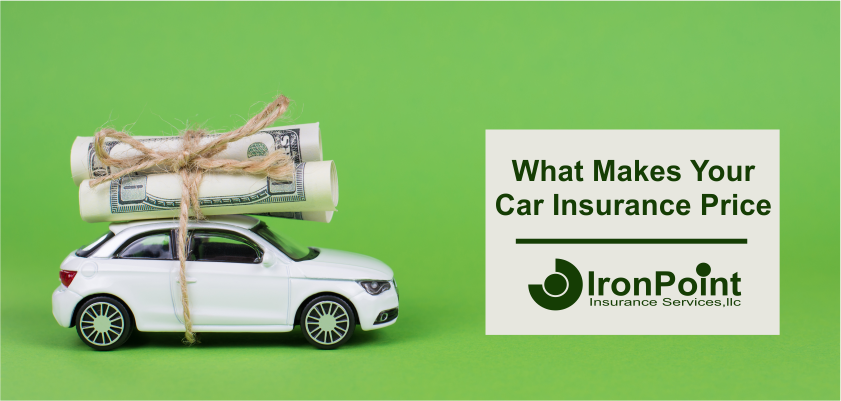What Impacts Your Car Insurance Price?

If you get a quote from an insurance agent or online, you are always asked very specific questions. These questions are used to gather the variables or both underwrite and price your car insurance. Now, there are many misconceptions about car insurance, and a lot of that has to do with how it’s priced. So, if you’ve ever wondered how what actually impacts your auto insurance price, we’re here to set some of that straight.
Setting the record straight: what impacts your price
First, we don’t intend to discuss here how your car insurance rates are developed. That’s a sophisticated actuarial and statistical treatment that deserves it’s own post. No, this post is intent to reveal the things that the statistical framework and actuarial work has revealed should either increases or decreases the factors that are used to set the prices. Also, as you read this post, you should understand that your final insurance premium is the result of a simple mathematical solution or algorithm that generally calculates your premiums by multiplying a set of factors against a base premium. A simple example could be:
Base Rate X Age X Gender X Marital Status X Model Year X Vehicle Symbol X Discount X Territory = Premium
While this example illustrates the idea, these algorithms can be fairly complex. Out intent here is to highlight the areas of these calculations where you can find some of the most impactful items that determine your insurance price. So let’s get started.
Teenage drivers
This isn’t going to surprise anyone. Teen drivers are 2.5 times more likely to be involved in a crash than drivers who are 20-24-year-olds, according to the California DMV. This kind of risk is a great example of factors that results in much higher premiums. It’s not all bad news, teens are really just a function of age and experience, as they get more experience the rates will decrease. Additionally, some insurance companies offer a Good Student Discount for eligible students, giving parents a little rate relief.
Driver’s Age
This is largely why your teen driver’s rates are so much higher. On average, rates decrease as you get older and gain more driving experience. At least until you reach about 75. If you’re keeping score at home, you can expect the biggest drops in rate at ages 19, 21, and 25. But remember, it’s not always your actual age, but rather the number of years you’ve been driving that’s the bigger factor.
See more on how age impacts your insurance rate.
How do you use your vehicle?
For some insurance companies, the way you use you car is factored into your premium. For instance, if you use your vehicle mostly for commuting to work or school or for pleasure, you’ll usually pay less than a driver who uses their vehicle for business or artisan uses. It’s important to note, if you use your vehicle for business or for ridesharing services like Uber and Lyft, some companies may charge you more, or may even require a commercial policy.
Speeding and other traffic violations
If you have only a single violation in a three-year period, there are some companies or programs that may allow you to avoid a charge all together. However, if you get two or more tickets in a three-year period, you’re most likely going to see an increase in price. The good news is the increase won’t be permanent, and speeding tickets typically fall off your driving record after a few years.
Those pesky parking tickets are a pain to pay but will don’t affect your insurance premium, the types of violations that impact your insurance price are generally the moving violations.
See more on how speeding tickets impact your insurance rate and by how much.
At-fault accident history
Your at-fault accident history is just like tickets and violations. In fact, nearly all at-fault accidents will result in an increase in your rate. However, like tickets and other violations, these increases aren’t permanent, and off your record after a few years.
Some insurance carriers have an accident forgiveness program, and if you’re enrolled in one of these programs, then accidents don’t always raise your rate. Many insurance companies offers accident forgiveness as either part of a package you purchase or because of eligibility due to loyalty or other underwriting criteria. If you are interested, you should ask you insurance agent if your company offers such a program.
Not-at-fault and one-car accidents
There’s no easy answer here, as this varies by state. In many states, you won’t see an increase at all for a not-at-fault accident. But in other states, your company could increase your rate—so it depends on your state and your insurance company.
One-car accidents are considered at fault by insurance companies because there is no other driver involved.
Location or what is called “territory”
Where you normally part you car is also a determination of the premium you may pay. This is driven by your ZIP. Where you garage your vehicle is actually one of the most important factors in determining how likely you are to have an incident. If park and drive your vehicle in a highly populated area, you’re at a higher risk for theft, collisions, and harm to your car. This will drive up the price of your car insurance, especially the comprehensive and collision coverages.
Coverage selections
Coverage selection will also drive your premium costs. The more coverage you have, the higher the rate. This is simply because your are buying “more.” It’s important to try many different options, because you may discover that increasing your coverage amounts by thousands has only a small increase in premium. Your deductible amount will also impact your rate.
The higher your deductible, the more of the repair or claim cost you’ll have to take on. That means your out-of-pocket costs will be higher, but you’ll have a lower overall rate and vice versa.
See more on how car insurance deductibles impact your price.
If you are making payments on your vehicle, consult with your financer to find out if they require a maximum deductible or certain coverages.
The payment plan you choose
When you buy auto insurance you’ll be offered different payment plans and ways to make those payments. Most insurance companies offer a variety of discounts depending on how you pay. For instance, you may get a discount for paying in full, receiving and signing your documents online, or making your payments electronically. Not only can you get discounts, but often you can avoid billing fees, or get reduced fees based on your payment options.
Home many miles you drive
In California, the annual miles you drive your car is a significant determinant of price. In fact, even outside California, insurance companies focus on how often you drive and may charge you more if you drive a lot. A company like Progressive rewards low mileage drivers through there Snapshot® program, which personalizes your car insurance rate based on your driving habits. While their Snapshot® program is well know, many insurance companies offer usage-based models today.
Learn more on about usage-based auto insurance.
Credit or Insurance Score
Some insurers will use information contained in your credit record to develop an insurance score. This is one of many factors that will impact your rate. While an insurance score is not a “credit score,” generally speaking, a better credit score does correlate with a better insurance score and therefore a better rate. Insurance uses for credit don’t impact your score, so you can quote as many times as you want when shopping for auto insurance.
Prior or continuous insurance habits
If you have no lapses in coverage, cancellations, or gaps in your insurance insurance history, you’ll typically get a lower rate. Some insurance companies actually offer discounts for the number of months you were continuously insured. This means you can be rewarded for the amount of time you were insured with your previous insurance company when buying you new policy. When you get continuous insurance or loyalty discounts, this basically means the longer you’ve been with the same company, the better the savings.
High Performance Vehicles
If you drive a high performance vehicle, you can expect to pay more for car insurance. Sometimes this is as simple as the size of the engine, because a large, V-8 engine can make it easier to speed or engage in reckless driving, which could mean a higher rate. Sometimes, though, it’s the horsepower to weight ratio that dictates the performance. It’s not completely intuitive, but the obvious cars (eg. Corvettes) should drive higher premiums.
Pro tip: Check with your insurance agent for insider tips to reduce your rate
If you’re not sure just how to save money, a sure fire way to save on home and auto insurance is to bundle your policies with one company. Most insurance companies offer multi-policy discounts, which may increase for having additional policies like motorcycle, boat, RV, and more. Plus, different companies might offer different ways to reduce your rate, so you can get the lowest possible option.
See more on bundling insurance. You can also find more tips to get affordable car insurance.

Compare Quotes Online
Want to know if you can save on home or auto insurance? See for yourself. Start a quote today.
Give us a Ring
1-877-334-7646
Call today and speak with a professional insurance agent.